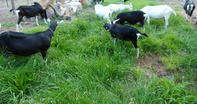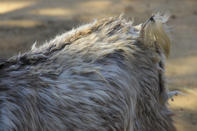South Africa is a relatively minor goat producing country, possessing approximately 3% of Africa’s goats and less than 1% of the world’s goats.

Goats are found throughout the country with Eastern Cape, Limpopo and KwaZulu-Natal provinces being the largest producers, accounting for approximately 70% of the total live goats. Goats in South Africa are bred for meat, milk, and fibre (mohair and some cashmere).
Meat, Milk and Fibre Goats

The most important commercial goat breeds for meat are the Boer goat, Savanna and Kalahari Red which can also produce small quantities of cashmere. Goat meat is called chevon (from adult goats) and cabrito when the meat is from young animals.
Chevon is between 50-60% lower in fat than beef but has the same protein content. Chevon is also lower in fat than chicken. Lesotho is the leading importer of chevon, accounting for 74% of South Africa’s export market of chevon in 2016.
The utilisation of the fibres as an additional source of income would make goat farming in South Africa more profitable. In addition, the establishment of small agro-industries which convert the fibre into textiles will provide employment in rural areas.
Studies done in South Africa showed that indigenous goats such as the Boer goat, have two coats - the coarse guard hair, and a fine or cashmere type of fibre. But the quantity of cashmere fibre was generally not at a commercially acceptable level.
The cashmere production capacity must be seen in the light that, at present, the goats are primarily bred for their meat and milk - the cashmere type of down fibre they produce not being utilised at all. For this reason, it is important to find a balance between meat and fibre production.
Angora goats (Capra hircus aegagrus) produce mohair while the Russian Gorno Altai goats produce cashmere - a very fine fibre of 18,5 µm (micrometre) and finer. South African farmers produce about 60% of the world’s production of mohair, mostly in the Karoo region of the Eastern Cape, with most mohair exported from Port Elizabeth’s harbour.
Goat breeds for milk production are the Saanen, Toggenburg and British Alpine goats. These are called milch goats. Goat’s milk is prized for its quality. Goat milk has a lower lactose content than cow milk and contains no A1 casein, a protein that can cause inflammation in many users.
Indigenous Goats in South Africa

‘Indigenous goats’ refer to various goat breeds of small-scale producers and contribute primarily to family needs for meat and to a lesser extent for milk, depending on the preferences of the community. Indigenous goats also grow cashmere during winter.
The indigenous goat was found mainly in the Eastern Cape province, but breeders and farmers are now found throughout the country. This goat is neither regarded as a commercial meat goat (due to its small carcass) nor is it regarded as a milk goat as it only produces enough milk for its kids. It has huge value in the cultural meat market; used for religious and other cultural celebrations in South Africa.
The indigenous veld goat association (IVG) is very active in South Africa, arranging regular information days and auctions. Commercial goat farmers mainly own Boer goats (meat) and Angora goats (fibre) while smaller farmers mainly own indigenous goats in a communal farming system.
Indigenous goats represent around 65% of the goats in South Africa, but from careful selection and crossbreeding of indigenous goats, the three main meat goats - the Boer goat, Kalahari Red and Savanna were developed.
By Marinda Louw